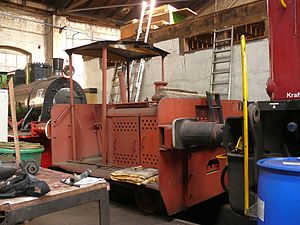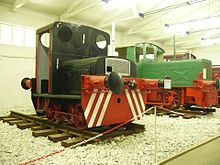Deutz OME 117 R
| Deutz OME 117 R | |
|---|---|
|
Deutz OME 117 R in Dieringhausen
|
|
| Manufacturer: | Klöckner-Humboldt-Deutz AG |
| Year of construction (s): | 1932-1942 |
| Axis formula : | B dm |
| Gauge : | 900-1676 mm |
| Service mass: | 10 t |
| Top speed: | 2.5-11 km / h |
| Installed capacity: | 12 hp |
| Number of cylinders: | 1 |
| Motor type: | KHD OME 117 |
| Motor type: | Two-stroke diesel engine |
| Power transmission: | Chain / bar |
| Locomotive brake: | Air brake |
Deutz OME 117 R is a shunting locomotive manufactured by (Klöckner-) Humboldt-Deutz in Cologne from 1932 to 1942 with a 12 hp single - cylinder two-stroke diesel engine . The gauges offered ranged from the 900 mm narrow gauge to standard gauge to the Indian broad gauge (1676 mm). The R (for shunting locomotive) distinguishes it from the narrow-gauge Deutz OME 117 F light rail locomotive with the same motor .
history
Klöckner-Humboldt-Deutz (KHD) and OK Nordhausen were the largest manufacturers of light rail locomotives in Germany until 1945 . The largest part of all rail vehicles built by Deutz up to that point were narrow-gauge field and mine locomotives. Standard gauge small locomotives (gauge 1435 mm), such as B. Deliveries by Köf II to the Deutsche Reichsbahngesellschaft were in the minority with around 10% of the total number of rail vehicles built by Deutz. After all, after the economic crisis of the 1930s, the number of locomotives built per year rose to over 1,000 in the following years. The most common type built were machines with the OME 117 engine. With the appearance of the OME 117 light rail locomotive in 1932, a standard-gauge version was offered.
development
With the designation OME 117 for standard-gauge factory locomotives, apart from the motorization, there were, unusually, two fundamentally different locomotive series.
On the one hand, using the existing technology from the OME 117 field railway locomotive, which had been supplied in over 2,000 units since the early 1930s, a simple, driver's cab-less shunting device for shifting individual vehicles on standard gauge was in the program. As a result, it looks like a light rail locomotive and instead of buffers with damping elements only had a rigid ram protection and shock device.
On the other hand, at this point in time (1932), a standardized type range of different performance classes was offered for the relatively few standard-gauge locomotives to be supplied to factory and private railways. From this only the two-cylinder types OMZ 117 and OMZ 122 were produced in significant numbers. The smallest representative was a very small shunting locomotive with driver's cab, also known as OME 117 because of the single-cylinder engine used. In contrast to the simpler standard-gauge light rail locomotive, it had buffers, spoked wheels and a draw hook for the standard coupling.
A total of about 50 machines of both versions were built.
Use and whereabouts
From the known résumés, most of the locomotives had been in service for at least 40 years. In contrast to the stronger types, repowering is little known.
A few examples of both types have been preserved. Externally restored, for example, a machine of the construction derived from the field railway types exists in private ownership on the grounds of the Hanau Museum Railway. Another machine of this type is available in the railway museums in Nördlingen and Dieringhausen.
The variant derived from the standard program has been preserved in the Prora railway museum on Rügen, for example in the form of a former factory locomotive with the number 1 of Schwartauer Werke AG in Bad Schwartau.

